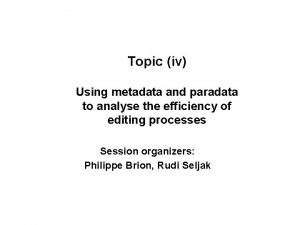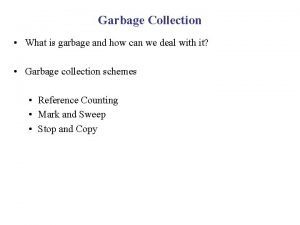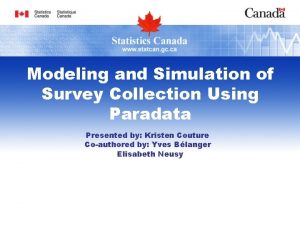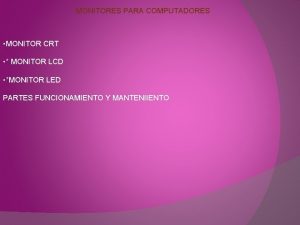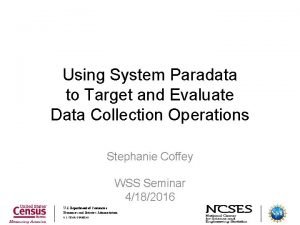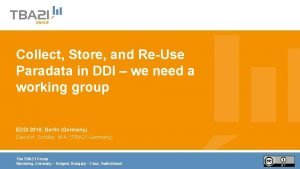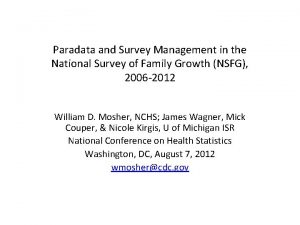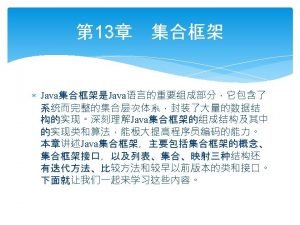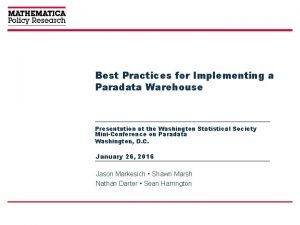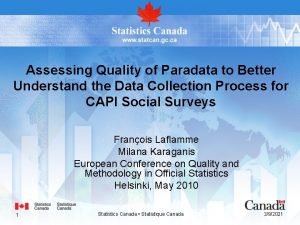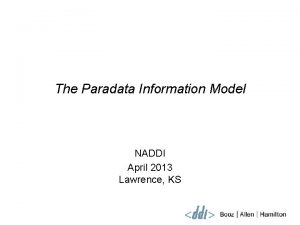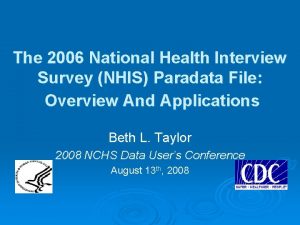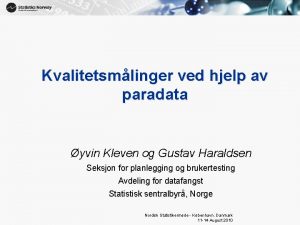Using Paradata to Monitor and Improve the Collection





























- Slides: 29

Using Paradata to Monitor and Improve the Collection Process in Annual Business Surveys By Sylvie De. Blois, Statistics Canada Rose-Carline Evra, Statistics Canada ICES-III, Montreal, June 19 th, 2007

OUTLINE Introduction Score Function Paradata Score Function Recent Update Future Developments 2

Introduction The Unified Enterprise Survey (UES) is an annual economic survey on financial and characteristic variables, which has been conducted by Statistics Canada since 1998. It combines many surveys. Average collection period: February to early October Collection Processing System: Blaise More than 48, 000 questionnaires each year. 3

UES Questionnaire UES includes Services, Trades, Manufactures, Agriculture (aquaculture) and Transportation (couriers and taxi & limousine) surveys. A questionnaire has about 7 to 10 sections (the number of sections varies depending on the survey): Introduction (Stats Act - Confidentiality, Respondent info) Revenue Expenses Events that may have affected business units … Comments 4

Introduction Collection Process: Mail-out of questionnaires Follow-up in case of non-response for some units / Mail-back of questionnaires Verification of received questionnaires / Edits Coding of questionnaires Imaging & Data Capture Sometimes during the collection period, followups are required due to non-response. The score function is used to determine the priority of an enterprise in follow-up. 5

Introduction Collection follow-up tool: Score function (SF) Annual Survey of Manufactures (ASM) score function Non-ASM score function Both score functions have their own ways of calculating scores, defining cells and priorities. This presentation will focus mainly on the Non -ASM score function. 6

Score Function Reduces collection costs yet retains data quality. Similar to the collection goal of obtaining a high weighted coverage response rate PRIORITY 1: Extensive follow-up for the larger revenue Collection Entities (CE) in cases of nonresponse. PRIORITY 0: Minimum follow-up for the smaller CE’s in cases of non-response. 7

Useful definitions NAICS = YYYYY PROV = AA A Cell B Sampling Unit (part of the enterprise within the cell) C D E Establishment NAICS: North American Industry Classification System (5 -digit number) 8

Method: Initial Scores Within each cell, calculate the score for each UES sampling unit (SU). Score = the sample weighted revenue of the SU as a percentage of the cell’s total revenue. Sample weight: UES sampling weight Revenue: Sampling Revenue 9

Method: Initial Scores Cell: For Distributive Trades & Aquaculture: NAICS * Province For Transportation: NAICS*Prov*Stratum(Take All /Take Some) For Services: NAICS*Prov*Stratum(TA /TS)* Type of questionnaire (long / characteristic) 10

Method: Initial Scores Within each cell Sort SUs by descending score Cumulate to the survey’s target coverage threshold for the Priority=1 s, and the rest are Priority=0 s. 11

Method: Dynamic Scores During collection process, twice a week, we: 1. receive updated response codes; 2. recalculate the scores within the cell (i. e. make it dynamic) to update priorities; 3. update priorities on Blaise, the collection tool. 12

Method: Dynamic Scores As collection proceeds: Response (received or completed) questionnaires contribute to the cell threshold Non-response questionnaires contribute nothing to the threshold Out-of-scope are removed entirely from the cell (reduces the cell’s revenue total) In-Progress questionnaires are still being collected (include appointments) 13

During Collection New total weighted revenue for the CELL (exclude the OOS). CELL: XXXX Total: 475, 000 k Received or Completed 15% reached In progress Priority 1 50% left to do Priority 1’s or 0’s received or completed contribute to reaching the CELL threshold. Threshold= 65% (308, 750 k) In progress Priority 0 NON-RESPONSE OOS 14 50, 000 k

Method: Dynamic Scores Has the cell reached its threshold? If yes, stop follow-up. If no, recalculate scores using In-progress units and the remaining threshold. Some cells must close due to lack of In-Progress questionnaires Some In-progress Priority 0 s may be promoted to Priority 1 s. 15

Paradata Definition: All variables directly related to data collection process Currently used: Response code Appointment reason (edit – data collection) Appointment date (recently added) Currently used only by Annual Survey of Manufactures (ASM): Number of attempts, commodity revenue and shipment revenue Could possibly be used: Type of contact with the respondent Previous year’s response code Type of reminder sent / Date / # (mail, remail, …) Others 16

Score Function Recent Update Recently, a study was done on the impact of appointments on the response rate (for reference year 2003). Following our findings the “appointment date” was added as paradata into the score function. 17

Appointments: The Study During the collection period, an appointment might be scheduled with the respondent. “Does the fact of having a appointment affect the response rate? ” Note: When an appointment is made and it’s a priority 1 questionnaire, it remains in the SF with a priority 1 with the “still in progress status”. Therefore, no priority 0 will be put as priority 1. 18

Response Rates: app versus no app The response rate is significantly lower for the questionnaires with an appointment. RY 2003 (Non-ASM surveys) 19

Response Rates: Scheduling of the appointment The response rate is significantly lower for questionnaires when the appointment is made toward the end of the collection period. 20

Other Facts The longer a questionnaire stays in appointment, the greater is the probability of that questionnaire being a non-response at the end of the collection period. 23. 8% of the questionnaires with appointments were classified as nonrespondent, because at the end of the collection period their cases were still open. 21

Appointment: Conclusion When possible, we should avoid making an appointment. Especially, at the end of the collection period. In cases of appointments, follow-up should occur soon after the appointment is made. An appointment is still a good way of improving the response rates. The treatment of the appointments in the score function should be modified. Extra “In progress” units will be promoted to priority 1 in order to compensate for possible non-response. 22

Facts / Findings A unit may not have an appointment date or may have one that is constantly changing. Many appointment dates are within a few weeks. It was decided to only consider units that have a late appointment date, and there are not many. 23

Facts / Findings An appointment can mean many things. Many unexpected factors caused the changes to be less efficient than initially expected. 24

Human Errors The interviewer: Enters the wrong value for a variable (for example, appointment reason) Does not update a key variable (for example, appointment date) 25

System Problems System Failures As a result, some variables are affected, like the number of attempts. Files not properly loaded Missing values or variables Some follow-up events occur outside of the system 26

Theoretical / Practical Appointment date is also used to set the “remail” (remail of questionnaire) and fax date. Also, some appointment dates are default dates (differ from survey to survey). Appointment is also used as a reminder to the interviewer to call a respondent unavailable at the moment of the initial call. 27

Future Developments Establish what is really an appointment; do more studies on the appointments. Study more paradata to “quantify” the importance of each unit, give priority and improve the score function. Introduction of a cost function to help assign the priority and the type of follow-up. Combine the ASM score function and the Non-ASM score function. 28

Thank You / Merci!!! Questions ? ? ? Pour plus d’information veuillez contacter / For more information, please contact: Rose. Evra@statcan. ca ou / or Sylvie. De. Blois@statcan. ca
 Paradata vs metadata
Paradata vs metadata How to monitor and improve workplace operations
How to monitor and improve workplace operations Landsat collection 1 vs collection 2
Landsat collection 1 vs collection 2 Documentary collection
Documentary collection Garbage collection in java
Garbage collection in java Hình ảnh bộ gõ cơ thể búng tay
Hình ảnh bộ gõ cơ thể búng tay Lp html
Lp html Bổ thể
Bổ thể Tỉ lệ cơ thể trẻ em
Tỉ lệ cơ thể trẻ em Chó sói
Chó sói Tư thế worms-breton
Tư thế worms-breton Chúa sống lại
Chúa sống lại Môn thể thao bắt đầu bằng chữ đua
Môn thể thao bắt đầu bằng chữ đua Thế nào là hệ số cao nhất
Thế nào là hệ số cao nhất Các châu lục và đại dương trên thế giới
Các châu lục và đại dương trên thế giới Cong thức tính động năng
Cong thức tính động năng Trời xanh đây là của chúng ta thể thơ
Trời xanh đây là của chúng ta thể thơ Mật thư anh em như thể tay chân
Mật thư anh em như thể tay chân Làm thế nào để 102-1=99
Làm thế nào để 102-1=99 Phản ứng thế ankan
Phản ứng thế ankan Các châu lục và đại dương trên thế giới
Các châu lục và đại dương trên thế giới Thơ thất ngôn tứ tuyệt đường luật
Thơ thất ngôn tứ tuyệt đường luật Quá trình desamine hóa có thể tạo ra
Quá trình desamine hóa có thể tạo ra Một số thể thơ truyền thống
Một số thể thơ truyền thống Cái miệng xinh xinh thế chỉ nói điều hay thôi
Cái miệng xinh xinh thế chỉ nói điều hay thôi Vẽ hình chiếu vuông góc của vật thể sau
Vẽ hình chiếu vuông góc của vật thể sau Thế nào là sự mỏi cơ
Thế nào là sự mỏi cơ đặc điểm cơ thể của người tối cổ
đặc điểm cơ thể của người tối cổ Ví dụ về giọng cùng tên
Ví dụ về giọng cùng tên Vẽ hình chiếu đứng bằng cạnh của vật thể
Vẽ hình chiếu đứng bằng cạnh của vật thể
